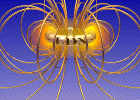|
The Dipole Fusion Confinement Concept |
|
|
The Levitated Dipole eXperiment Welcome to the Levitated Dipole eXperiment (LDX) web
site. LDX is a novel experimental device designed to explore the physics
of plasma confinement in a magnetic dipole field. What makes it unique?
Besides levitating a 1/2 ton superconducting ring, we will conduct the
first experimental test on the theory of plasma confinement by adiabatic
compressibility. If this concept turns out to be correct, levitated dipoles
may one day make an attractive magnetically confined fusion energy source.
LDX is a collaboration between Columbia
University's Dept. of Applied Physics and the MIT
Plasma Science & Fusion Center and is funded by the Department
of Energy's Office of Fusion Energy.
The movie was created on an Apple PowerMacintosh G3 using a 3D rendering program called "POV-Ray". You may download the movie in three QuickTime versions:
Previous studies [1-4] indicate that a levitated dipole would be favorable for a D-He3 fuel cycle based power source. The D-D cycle is the most promising because of the availability of deuterium. Recently we have considered utilizing a levitated dipole for the D-D cycle based power source. Fusion reactors based on the deuterium-deuterium (D-D) reaction would be superior to D-T based reactors in so far as they can greatly reduce the power produced in neutrons and do not requires the breeding of tritium. In a recent article titled "Helium Catalyzed D-D Fusion in a Levitated Dipole" we have proposed a fusion power source, based on an alternative fuel cycle which we call ``helium catalyzed D-D". We have explored the application of a levitated dipole as a D-D power source and found that a dipole may have the unique capability of producing excellent energy confinement accompanied by low particle confinement. Additionally a levitated dipole device would be intrinsically steady state and extract power as surface heating, permitting a thin walled vacuum vessel and eliminating the need for a massive neutron shield. We find that a dipole based D-D power source can potentially provide a substantially better utilization of magnetic field energy with a comparable mass power density as compared to a D-T based tokamak power source. SOURCE - MIT
Plasma Science & Fusion Center
|
|
|
A White Paper for the Fusion Community J. Kesner and L. Bromberg MIT Plasma Science and Fusion Center
Department of Applied Physics, Columbia University
Department of Physics, UCLA
Introduction The dipole magnetic field is the simplest and most common magnetic field configuration in the universe. It is the magnetic far-field of a single, circular current loop, and it represents the dominate structure of the middle magnetospheres of magnetized planets and neutron stars. The use of a dipole magnetic field generated by a levitated ring to confine a hot plasma for fusion power generation was first considered by Akira Hasegawa after participating in the Voyager 2 encounter with Uranus [1]. Hasegawa recognized that the inward diffusion and adiabatic heating that accompanied strong magnetic and electric fluctuations in planetary magnetospheres represented a fundamental property of strongly magnetized plasmas not yet observed in laboratory fusion experiments. For example, it is well-known that global fluctuations excited in laboratory fusion plasmas result in rapid plasma and energy loss. In contrast, large-scale fluctuations induced by sudden compressions of the geomagnetic cavity (due to enhancements in solar wind pressure) or by unsteady convections occurring during magnetic substorms energize and populate the energetic electrons trapped in the Earth’s magnetosphere [2]. The fluctuations induce inward particle diffusion from the magnetospheric boundary even when the central plasma density greatly exceeds the density at the edge. Hasegawa postulated that if a hot plasma having pressure profiles similar to those observed in nature could be confined by a laboratory dipole magnetic field, this plasma might also be immune to anomalous (outward) transport of plasma energy and particles... Rest of White Paper is here...
|
|
| FAIR USE NOTICE: This page contains copyrighted material the use of which has not been specifically authorized by the copyright owner. Pegasus Research Consortium distributes this material without profit to those who have expressed a prior interest in receiving the included information for research and educational purposes. We believe this constitutes a fair use of any such copyrighted material as provided for in 17 U.S.C § 107. If you wish to use copyrighted material from this site for purposes of your own that go beyond fair use, you must obtain permission from the copyright owner. | |
| ~ MENU ~ |

